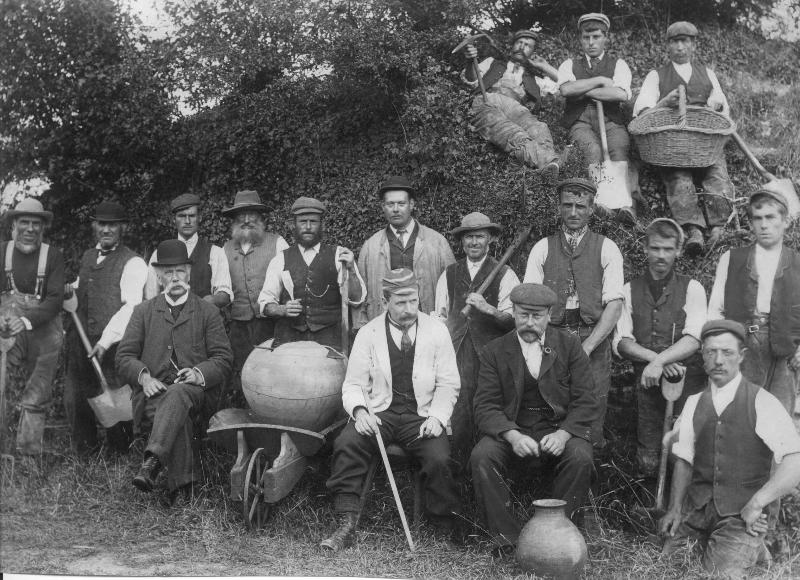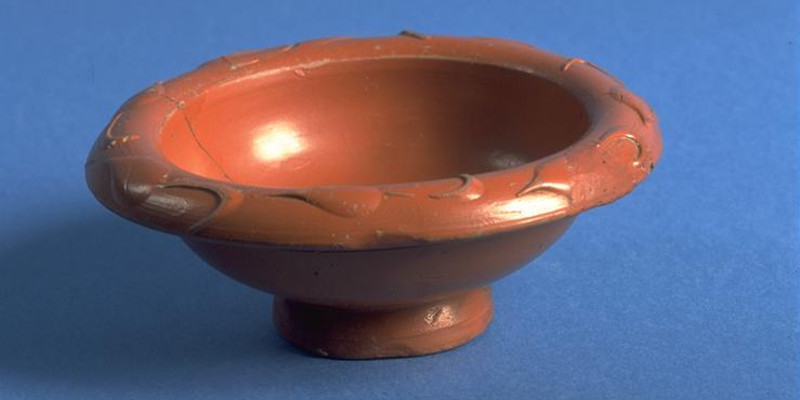In the last two-hundred years, archaeological excavations at the Roman town at Silchester (Calleva Atrebatum) have revealed large numbers of significant pieces of Romano-British pottery. Many different types have been found, from ceramics made by nearby kilns in the south of England, to pieces imported from abroad. Each object provides us with rich insights into the lives led by people in Britain thousands of years ago.
Iron Age pottery
Whilst Silchester is most famous as the Roman town, people lived in Calleva before the Roman conquest of Britain. These were the Atrebates, a Celtic tribe that settled in South East England in the 1st century BC, as Calleva became the centre of their kingdom.
Archaeologists working at the Silchester site have found many examples of pottery dated to the pre-Roman period. This Iron Age beaker was crafted between 20 AD and 69 AD.

An Iron Age beaker. (REDMG : 1995.1.87)
Alice Holt ware
Much of the pottery discovered in Silchester was produced in the local Hampshire area. One kind of pottery was known as Alice Holt ware, because it was made at pottery kilns in the Alice Holt Forest. These Alice Holt kilns produced a course grey sandy ware, such as this jar, discovered in 1908 during excavations by the Society of Antiquaries.

An Alice Holt ware jar. (REDMG : 1992.1.1497)
New Forest pottery
Another area of important pottery-making in Roman Britain was the New Forest. This grey ware storage jar came from a New Forest kiln between 220 AD and 299 AD.

The Jubilee Pot. (REDMG : 1995.1.88)
This pot is decorated with bands of lattice and shows signs of having been restored. It is known as the Jubilee Pot because it was found by excavators from the Society of Antiquaries on the day of Queen Victoria's Diamond Jubilee in 1897!
The neck inscription 'VI=' is a measurement of capacity, possibly six and two fractions urnae (about eighteen gallons) or, if a dry measure, six and two fractions modii (about twelve modii or three bushels).

Excavators from the Society of Antiquaries pose by their finds on the day of Queen Victoria's Diamond Jubilee, 1897. Photograph by F. Mason Good. (REDMG : 2002.34.109)
Oxfordshire potteries
This mortarium, made between 180 AD and 239 AD, originates from an Oxfordshire pottery. Mortaria were used to grind up foods and spices. This one still contains the remains of cherries and plums. One of these fruits must have been preserved because they ripen at different times of the year. Traces like these provide us with rich insights into the different kinds of foods that ancient people produced, traded, and consumed.

A mortarium made in Oxfordshire. (REDMG : 1992.1.1611)
Terra sigillata
In the Roman period, all kinds of resources were traded across the ancient world. Pottery and ceramics were no exception!
One of the most recognisable types of Roman pottery is known as terra sigillata, commonly known as Samian ware. Terra sigillata is famous for its red glaze, an effect produced by colouring ordinary glass with red iron oxide, finely ground, and mixed in a thin water slip solution. When fired, the moulded and incised ornaments on the vessels remain visible and distinguishable through the delicate glaze.
This terra sigillata dish features barbotine decoration around the rim. It was made in Central Gaul, modern-day France, and dates to between 125 AD and 150 AD, showing signs of restoration since. The pot's shape is a standard form called Dragendorff 35.

An example of terra sigillata ware. (REDMG : 1995.81.1332)
Roman amphorae
The remains of amphorae found at Silchester suggest a trading relationship with southern Europe. Amphorae were used to transport wine and oil, and many examples were found across the site. These include pre-Roman and Italian long-bodied amphorae, and Spanish globular-bodied amphorae. It's very possible that these vessels could have been re-purposed and re-used by the people of Silchester for many years after they were first used.
This neck and handle of an amphora came from Andalusia in Spain. The handle is stamped ‘SCAL.CELS’, which has been interpreted as a reference to Scalensia, perhaps the owner of an olive oil estate, and Celsus, a foreman.

Neck sherd from an amphora. (REDMG : 1995.2.1500)
Black ware
Another piece made in central Gaul is this striking Gallo-Belgic black ware beaker. The drinking vessel, made between 150 AD and 240 AD, is decorated with a motto in black slip that reads 'VITAM TIBI', which means: ‘long life to you’. Almost two thousand years later, we are sure this object has led a much longer life than its crafter could ever have imagined.

Motto beaker (museum number REDMG : 1995.1.160)
Explore the Silchester Collection at Reading Museum
If you are interested in learning more about Roman pottery, and the rich stories these pieces tell of ancient life in Britain, visit Reading Museum's Silchester Annexe. The gallery displays over 200 vessels from the Silchester site.





